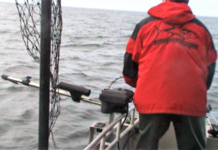
A team of research divers positions the end of a dredge hose for excavation of a site off Florida’s Gulf Coast during the Submerged New World 2012 expedition.
Did You Know?
Technologies, such as remotely operated vehicles and autonomous underwater vehicles, allow marine archaeologists to explore shipwrecks at greater depths than possible by human divers. Research indicates that as recently as the middle of the 19th century, nearly 20 percent of shipwrecks occurred in deep water away from shore. Comparing deep and shallow water wrecks with information from land excavations can give scientists a new understanding of the ancient world.
When it comes to marine archaeology, the most common (and perhaps most popular) type of sites studied are shipwrecks. However, marine archaeologists also investigate other kinds of sites, such as flooded land sites or fishing structures.
Underwater archaeological excavation is very similar to traditional land archaeology. Marine archaeologists use similar tools, but will opt for the plastic version of the tool so that it does not fall apart in the salt water. The archaeological goal of excavating materials in a controlled fashion where the original location of each object or artifact can be recorded and analyzed later is the same wherever you dig. The methods employed as we work underwater are slightly different because of the environment and the need for some different tools.
Most “tools of the trade” used on terrestrial archaeological digs are used for underwater excavations as well. Hand trowels, square units, clipboards, pencils, tape measures, and other hand tools are all used underwater to excavate sites as they are used on land.
However, rather than shovel dirt into a bucket or wheelbarrow and bringing it to a fine screen to shake it, or wash it with water to remove the dirt, marine archaeologists use a 100-foot hose connected to a large dredge engine with a pump that moves 600 gallons of water a minute to suck the seafloor sediments like a giant vacuum cleaner. The dredge tube brings the sediments from the bottom and deposits them on an 8 by 12-foot floating screen deck that has mesh as fine as one-sixteenth of an inch to catch even the smallest of artifacts or bone fragments.
For More Information:
Underwater Archaeological Excavation Techniques, Exploring the Submerged New World 2012
Meet Beverly Goodman, Marine Geoarchaeologist, OceanAGE Career Profiles
Sign up for the Ocean Explorer E-mail Update List.














